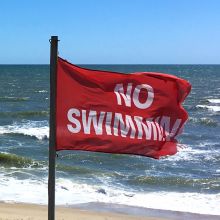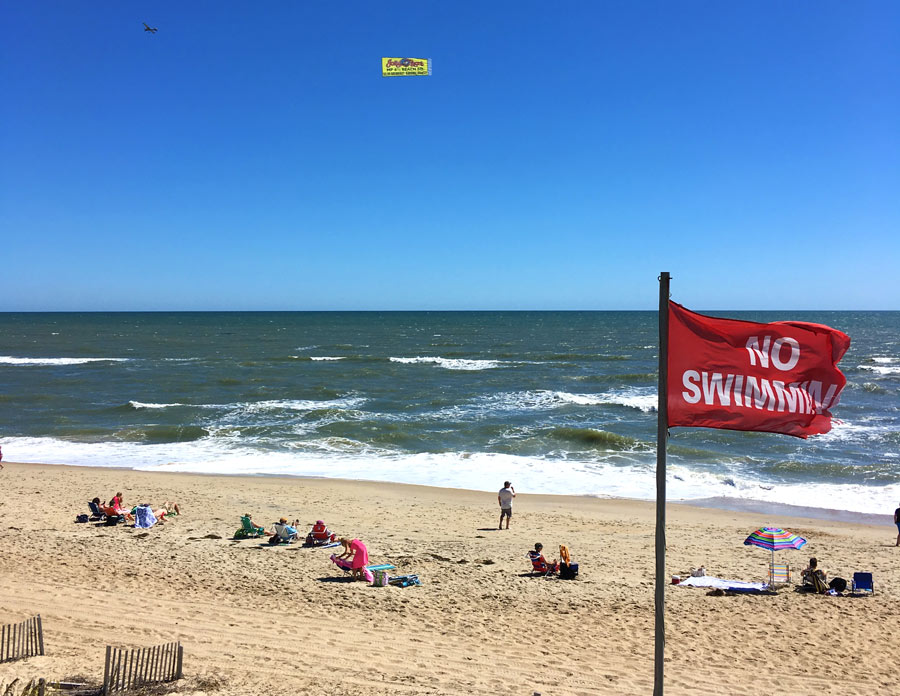
The beach is the place for sand, sun and fun. An oasis of total relaxation where all of your cares disappear. Right?
Until a rip current sweeps someone away.
In 2018 alone rip currents have claimed the lives of six people on the Outer Banks. The U.S. Lifesaving Association estimates that almost 100 people drown in rip currents every year. It’s a scary dose of reality that is always better to acknowledge and appreciate than to underestimate, or worse, ignore before it’s too late.
This week’s blog is all about water safety. Now hang on, don’t roll your eyes like that. Even the best and most experienced swimmers among us are not immune to rip currents. Savvy and even defensive practices in the water go beyond swimming alone or non-swimmers swimming. Whether or not you get caught in a rip current, these water safety tips and tricks will contribute to a carefree Outer Banks experience.
A Watchful Eye
The blistering sand and burning sun make it so tempting to charge into the sparkling blue ocean without a second thought. However, make sure you know what you’re getting into before you take that dive.
Red flags. Look around the beach access, the lifeguard stands, etc. If you see the red “no swimming” or the yellow “warning” flags, you might want to save your body board session for a later time. They fly for a reason, and believe it or not, they’re not meant to put a damper on your beach day.
Swim near a lifeguard. ‘Nuff said.
If no flags are out, scan the water. Do you see a break in the wave pattern? A channel of especially choppy water? Any sea stuff like foam or seaweed pulled seaward? These are all signs of a rip current. Patches of discolored water (better spotted when wearing polarized sunglasses) also mark rip currents.
And think logically – is there any reason the ocean could be rougher today? Is a storm brewing off the coast? Are you about to swim near a pier, groin or jetty? These may increase the likelihood of rip currents.
What to Do
No matter how cautious you are, sometimes it just so happens that you’re splashing about and notice the shore suddenly seems much farther away than you intended. If you paddle toward the shore only to realize that no matter how hard you stroke and kick you aren’t getting any closer, here's what you need to do:
Don’t panic. The worst thing you could do in a dangerous situation is lose your cool. You need a clear head to think and act strategically.
Don’t fight it. Swimming against a rip current only wastes valuable energy and time. Rip currents are narrow, about 10 to 200 feet wide, and run perpendicular to the shore. Your best bet is to swim out of the current, parallel to the shoreline.
Use a floatation device. If you have one with you, keep that float, body board, surfboard or water noodle by your side. Use it if you get tired.
Raise your voice. Signal someone on shore to call for help. Face the shore and wave your arms and call for help.
If worse comes to worse, just go with the flow. If you can’t swim out of the current, float with it until it ends. After that you’ll be able to swim parallel to shore and then at an angle back to the shore.
Finally, if you see someone else caught in a rip current, notify a lifeguard or call 911. Don’t go in after them unless you know you’re qualified to safely do so.
Everyone deserves a fun and relaxing day at the beach. Don’t let a rip current change that.




 Hannah Lee is a fiction and creative nonfiction writer living on the Outer Banks. She graduated from Kenyon College in Ohio with a degree in English Literature and Creative Writing. Traveling is her passion, but nowhere ever feels as much like home as the Outer Banks. When not planning her next trip or adventure, Hannah Lee loves aimless drives down the Beach Road, spending copious amounts of time in coffee shops and reading every short story collection she gets her hands on.
Hannah Lee is a fiction and creative nonfiction writer living on the Outer Banks. She graduated from Kenyon College in Ohio with a degree in English Literature and Creative Writing. Traveling is her passion, but nowhere ever feels as much like home as the Outer Banks. When not planning her next trip or adventure, Hannah Lee loves aimless drives down the Beach Road, spending copious amounts of time in coffee shops and reading every short story collection she gets her hands on. 

